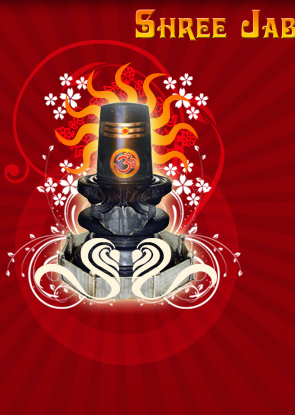
![]()
The twelve important Hindu temples in India dedicated to Lord Shiva are those with the Jyotirlinga or Jyotirlingam. These 12 temples are known as Dwadash Jyotirlingam or Jyotirlinga. The twelve temples attract millions of Hindu devotees and the most important common festival observed in these temples is the Maha Shivaratri or Shivratri.
Jyotirlingam means 'the linga of light' - the Shivalinga is in the symbolic form of a stone tinctured with a cycle of light. There are numerous legends associated with the origin of Jyotirlinga. It is believed that Lord Shiva for the first time appeared in the form of Jyotirlinga. The Jyotirlinga is an attempt by humans to give a form to the formless Brahman.
The twelve temples with Jyotrilinga in India are:
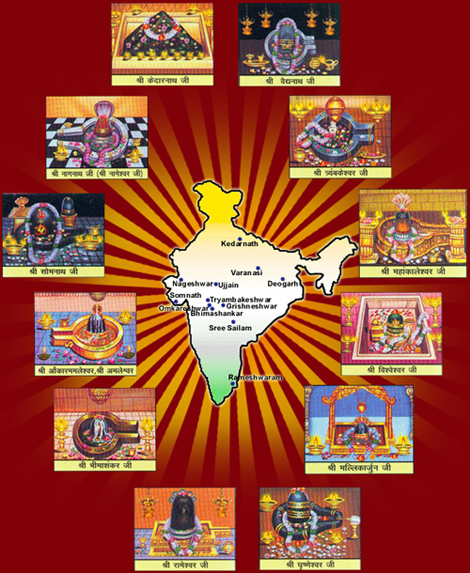
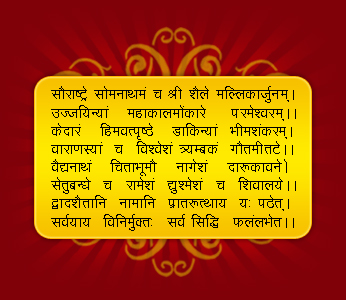
There is an important shloka dedicated to the 12 Jyotrilingas in the Shiva Purana.
Lord Somnath is in the country Saurashtra, Mallikarjuna is on the Shree Shailam, Mahakala is in Ujjayani, Parameshwar belongs to Onkar, Kedar in the mountain of Himalaya, Bhimashankar is in the country of Dakini, Viswesh belongs to Varanasi, the Lord Trayam bakam resides on the shore of Gautami river, Baidyanath lies on the land of ashes and the Lord of snake lives in the wooden forest. Lord Rama stays near the sea where it was bridged by him and Lord of Ghushma resides in the abode of Shiva. If one recites the twelve names in the early morning, he will get rid of all sins and will get all fruits of his efforts.
One who recites these 12 names regularly in the morning and evening washes all the sins committed in the previous 7 births and attains all the powers and Siddhis.
SOMNATH (Kathiyavad GUJARAT)
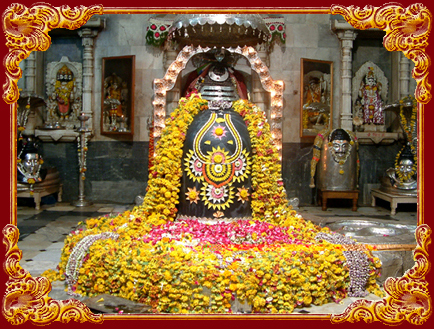
Chandra Devan worshipped Siva at this spot to rid himself of the curse of Daksha.
The story:
Chandra Devan is considered to have built this temple & hence the name Somanathar to the Lord. Chandran fell in love with Rohini, one of the daughters of Dakshan. But Dakshan wanted to give all his daughters in marraige to one able & loving person, who would treat all his daughters equally. Chandran got married to all, but his love for Rohini was too great & the other daughters complained to their father. Dakshan cursed Chandran to dwindle in power & beauty. When Chandran begged forgiveness, Dakshan said that only prayers to Lord Siva, could free him of the curse. Chandran came to Somanath & prayed to Lord Siva, doing penance for about 4,000 years. Lord Siva appeared & said that he could not fully absolve him of the curse. Instead, he would wane in 15 days, but would grow again. This is the story said for the waxing & waning of the moon, producing new moon & full moon.
MALLIKARJUNA(Srishailam ANDHRAPRADESH)
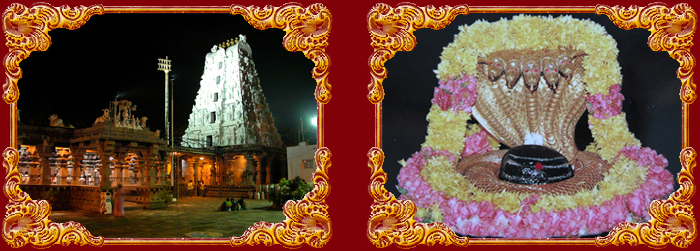
The story:
When Lord Shiva and Mata Parvati decided to find suitable brides for their sons, Ganesha and Muruga argued as to who is to get wedded first. Lord Shiva bade that the one who goes round the world in Pradakshinam could get married first. By the time Lord Muruga could go round the world on his vahana, Lord Ganesha went round his parents 7 times (for according to Sastras), going in pradakshinam round one's parents is equivalent to going once round the world (Boopradakshinam). Lord Siva got Siddhi & Buddhi, the daughters of Viswaroopan married to Lord Ganesha. Muruga on his return was enraged and went away to stay alone on Mount Kravunja in the name of Kumarabrahmachari. On seeing his father coming over to pacfy him, he tried to move to another place, but on the request of the Devas, stayed closeby. The place where Lord Siva and Parvathi stayed came to be known as Sri Sailam. Lord Siva visits Lord Muruga on Amavasai day & Parvathi Devi on Pournami. The temple is situated facing East. The centre mandapam has sveral pillars, with a huge idol of Nadikeswarar.
MAHAKALESHWAR (Ujjain Madhya Pradesh)
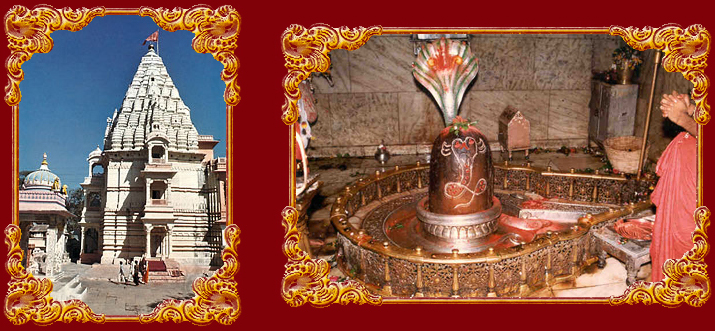
The theertam opposite the Mahakaleshwarar temple is known as Koditheertham & it is said that the colour of the waters of this theertham keeps changing. The Moola lingam is very small & is located underground. The lingam in the top level is called Ongareshwarar. The Kali Devi who gave darshan to Vikramaditya is known by the name Harasiddhi Mata.
The story:
There once lived a brahmin in Avanti, who had four sons, who were great devotees of Lord Shiva. Dushanan, a demon was giving trouble, disturbing all good & religious activities. The brahmins from all over the land gathered with the four sons & performed pooja to Lord Shiva. The spot where they had taken mud to make the Lingam, had become a huge pond. When Dushanan came to disturb their pooja, Lord Shiva rose from this pond as Mahakaleshwarar & destoryed Dushanan. On the request of the brahmins, Lord Shiva gave darshan to devotees at this sthalam, one of the Jyotir Linga sthalams.
OMKARESHWAR / MAMLESHWAR(At Naramada River Madhya Pradesh)
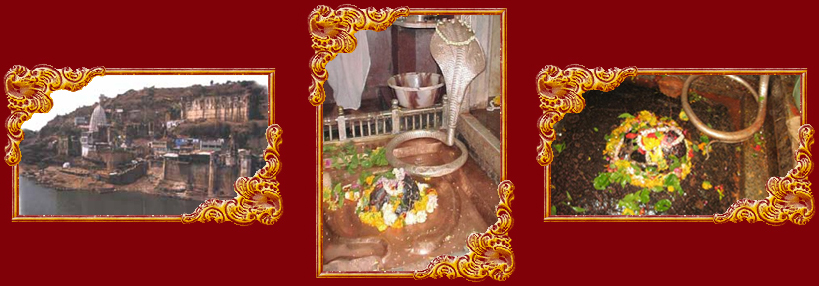
The Jyotir Lingam split into two, and there are two Shiva lingams, Omkareswarar & Amaleshwarar (Amareshwarar).
The story:
Mandhata was a great Emperor of the Ishvaku clan who ruled this land. He did great penance in this land & there is an ashram called Mandhata ashram here.
his spiritual and all powerful jyotirlinga of Lord Shiva is at Ujjain in Madhya Pradesh. There Lord Shiva came in the form of Mahakal out of the linga that split and killed the demon. Therefore all those who pray to this linga will never fear death and if their faith is true they will be out of the chakra of life and death. The Omkareshawar temple is built in the North Inidan style of architecture, with high spires. Devotees consider worship to Panchamuga Ganesha, to be very auspicious. There is a shrine for Annapoorani. Shiva Lingas of various sizes are sold in great numbers in this place. It is said that once, sage Naradar during his visit to the Vindyas, sang the praise of mount Meru to Mount Vindhya. On hearing this, Mount Vindhya prayed to Lord Shiva to gain in importance. Lord Shiva blessed him & appeared here as Omkareshwarar & Amaleshwarar and gave the boon of grwoing, but without hindering Shiva devotees. But the Vindhyas did not stop growing, and even obstructed the sun and the moon. Sage Agasthyar subdued its growth by saying it should not grow till he gets back there. He never went back & hence the growth was arrested. Omkareshwar is situated on the Mandhata hills in Madhya Pradesh, known in ancient times as Shivpuri. The temple dates back to the Krita Yuga. River Narmada flows here around the Mandhata hill in the form of an Om (Omkaram).
BAIDYANATH DHAM / VAIDYANATHAM(At Parli Deogarh Bihar)
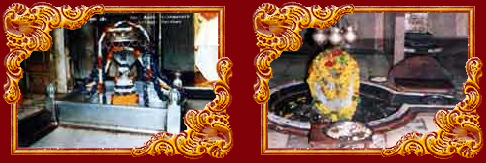
The story:
The demon lord from the Ramayan, the devout Ravana meditated hard in order to invoke Lord Shiva, and requested him to come over to Sri Lanka, in order that his capital may become invincible. It is said that he attempted to lift the holy mountain, Lord Shiva's abode, Mount Kailash and take it with him to his capital; however Shiva crushed him with his leg thumb, and Ravana prayed to him and sought his mercy, after which Shiva gave him one of the twelve Jyotirlingams with the condition that if it was placed on the ground it would take root immediately and hence Ravana had to carry it back on his trek to his capital. Varuna the God of water, entered Ravana's belly, and caused him to feel the need to relieve himself.
Vishnu then came down in the form of a lad and volunteered to hold the Jyotirlingam as he relieved himself. But before Ravana could return, the young lad placed the jyotirlingam on the ground to which it became rooted. A disappointed Ravana offered severe penances to Shiva here, and cut off nine of his heads as a part of his repentance. Shiva revived him and joined the heads to the body, like a Vaidya or a physician, hence this Jyotirlingam goes by the name Vaidyanath. The same legend holds at Gokarnam in Karnataka.
BHIMASANKARA (northwest of Poona, in Dhakini, MAHARASHTRA)
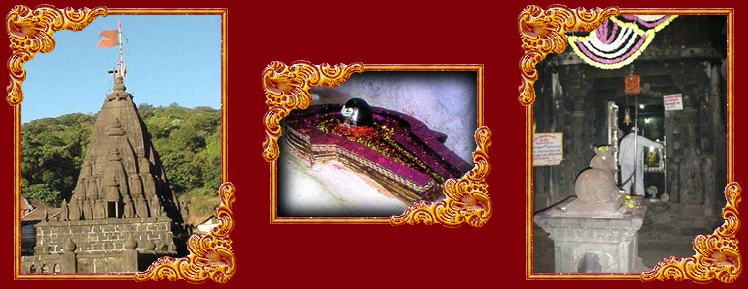
Bhimashankaram is located at Bhuvanagiri village in Puna district of Maharashtra. River Bhima has its source here. This temple in the Nagara style is an old and not a very large structure. The jyotir Lingam is situated on top of the Sahyadri hill temple. Lord Shiva is considered to be taking rest here after the Trpurantaka samharam. The sweat drops of Lord Shiva were converted as steam & is running as Bhimarati. New structures have been added. There are two idols of Nandideva. One idol is old, while the other is of fairly recent addition. There is a theertham & a well behind the temple structure. The Bhimashankarar Lingam measures around one and a half feet & quite narrow. The Goddess is worshipped as Kamalaja. Shivaji, the Maratha ruler had made rich endowments for the maintenance of the temple. The moola lingam is at a lower level.
The story:
Bhima was an asura, son of Kumbakarnan & Karkadi. On hearing that his grandfather, uncles & father had been killed by a brahmin & kings, he set out to destroy them. He undertook severe penance & got immense might and power from Lord Brahma. King Priyadarman of Kamarupa was also put under prison. Priyadarman & his wife Dakshinadevi prayed sincerely to Lord Shiva everyday. Fearing that they would overcome him, Bhima asked them to stop their prayers. When they refused, he set out to kill them. Lord Shiva rose out of the Lingam that they had been worshipping & slayed Bhima. On the request of the Devas, Lord Shiva resides here under the namam Bhimashankarar.
RAMESHWARAM (At SethuBandh TAMIL NADU)
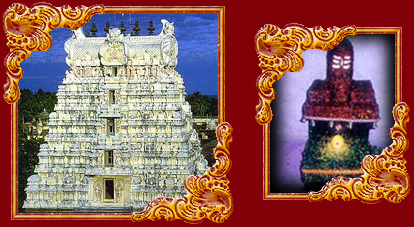
The temple at Rameshvaram, besides being considered a Dhama, is also one of the twelve sacred Jyotir Linga sites. These sites, located throughout the sub-continent of India, are where the god Shiva is said to have manifested as a towering column of fire.
The story:
The jyotirlingam was worshipped by Lord Rama to atone the sin of killing Ravana. Hanuman flew to bring the Linga from Kailasa, for Lord Rama to wroship. As it was getting late, Rama worshipped the Lingam that was made of sand by Sita Devi. This Lingam worshipped by Lord Rama is known as Ramanathar. When Hanuman returned he was disappointed that his Lord had not used the Lingam that he had brought. Lord Rama pacified Hanuman & named this Lingam Kasi Viswanathar. Devotees have to worship Kasi Viswanathar before worshipping Ramanathar.
This shrine is located at the extreme south eastern point of the Indian peninsula. The sethu bridge was constructed to link this land to Lanka for the Varnarams to reach Lanka. This island temple resembles the Panchajanya (Vishnu's conch) and like the Tamil letter 'OM'.
Rameswaram is famous for the many teerthams. There are a total of 51 teerthams, 22 of them situated within the temple. Pilgrimage is considered complete with a bath in the Agni teertham. These waters are considered to have medicinal qualities.
It is the custom to worship at Dhanushkodi before going to Rameshwaram. Several spots in this island are associated with Lord Rama. The Kothandarama temple stands at the spot where Vibeeshanan sought refuge to Rama.
NAGANATH / NAGESHWAR (Gujarat)
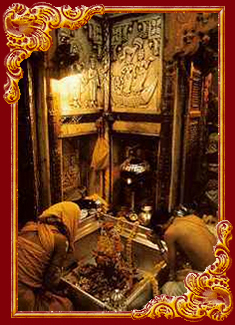
Nageshwar is located near Dwaraka, on the way to Beti Dwaraka.
The story:
There once lived a rakshasa called Daruka, who was extremely cruel and tortured the good ones. But yet he was a great devotee of Lord Shiva. A Shiva devotee, Supriya who was a merchant reached the Darukavanam, where Daruka lived with his wife Daruki, while sailing with his goods.
Daruka asked Supriya to teach him the path of devotion to Shiva, the norms of performing pooja and penance. Fearing that Daruka would use any additional powers gained by such penance, to bad use, Supriya refused to guide him. The enraged Daruka began to torture Supriya. Supriya however was staunch is his faith in the Lord and was unmoved by any torture. Lord Shiva was pleased and appeared and killed the demon Daruka. Daruki, Daruka's wife, now started giving even more trouble than her husband. Shiva vanquished her too and gives darshan to his devotees at this place as Nageshwar. The Nageswara Jyotirlingam is claimed to exist in 3 places in Dwaraka, in Audhgram, near Almora in Uttar Pradesh.
The Shivalingam is facing South, with the Gomugam facing East. There is a story for this position. A devotee by name Naamdev was singing bhajans in front of the Lord. Other devotees asked him to stand aside and not hide the Lord. To this Naamdev asked them to suggest one direction in which the Lord does not exist, so that he can stand there. The enraged devotees carried him and left him on the southside. To their astonishment, they found that the Linga was now facing South with the Gomugam facing East.
Kashi VISHWANATH (Banaras / Varanasi Uttar Pradesh)
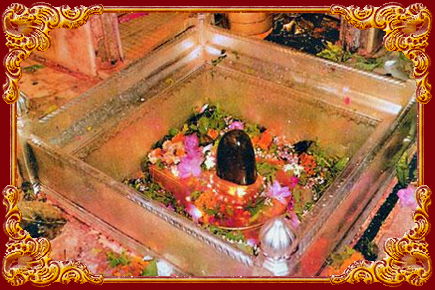
Kashi is amongst the holy spots for visit by the Hindus. It is believed that a visit to Kasi ensures liberation & hence pious Hindus seek a visit during their lifetime. The Lord himself has declared this spot as his Royal residence.
The story:
Goddess Parvati's mother felt ashamed that her son - in - law had no decent dwelling. To please Parvati Devi, Shiva asked Nikumbha to provide him with a dwelling place at Kashi.
On the request of Nikumbha, Aunikumbha a brahmin made Divodas construct a temple for the Lord here. The pleased Lord granted boons to all his devotees. But Divodas was not blessed with a son. The angered Divodas demolished the structure. Nikumbha cursed that the area would be devoid of people. When the place was emptied Lord Shiva once again took residence here permanently. The Lord along with Parvati Devi once again started blessing his devotees with wonderful boons.
Parvati Devi was so pleased that she offered food (annam) to one and all and hence is worshipped as Annapoorana. The Lord himself is seen with a bowl in his hands asking for annam from the seated Devi at the Devi's shrine adajacent to Viswanathar's shrine. This is considered to be one of the 52 Sakthipeedams (the place where Parvati's left hand fell, when her corpse was cut by Mahavishnu's sudarsana chakram). The Siva lingam is placed in a square shaped brass plated pit. Devotees are permitted to offer worship such as abhishekam with holy ganga water, garlanding the Lord, karpoora aarathi, etc. personally to the swaymbhu lingam.
There are several smaller shrines around the main shrine. The head of each ghat has a Siva linga shrine. The Lord can be seen placed on a pedestal at every location in the city, even if there is not shrine as such. Behind the temple is situated the temple of Dhundhiraja Ganapathi.
TRYAMBAKESHWAR(On the banks of river Gautami/Godavari, MAHARASHTRA)

The Triyambakeshwarar temple is located in the Triyambak town near Nasik. The temple is in the Indo Aryan style. The temple structure with excellent adornments of idols and sculptures, is surrounded by a massive stone wall. There is a huge bull in front of the temple & another marble Nandi is seen on the inside. The sculptural adornments continues even to the garbagriha with human, animals and yakshas carved. From the Jyotir Lingam at the centre of the garbagriha, trickles the Ganges continuously throughout the year. Sometimes, it is said flames issue forth as also a rumbling sound.
KEDARNATH(Utterkhand Himalayas, UTTARANCHAL)
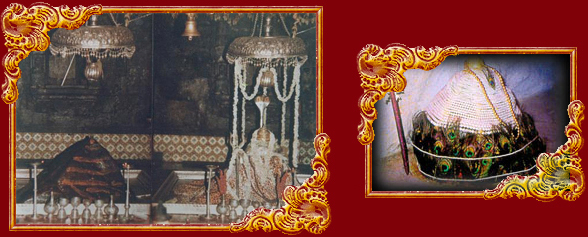
Kedarnath, at the head of the Mandakini River, is amongst the holiest pilgrimages for the devout Hindu. The temple, believed to be very ancient, has been continually renovated over the centuries. According to legend.
The story:
Lord Shiva wished to elude the Pandavas, and took refuge in Kedar - nath in the form of a bull. On being followed, He dived into the ground, leaving behind His hump of the surface. The hump is worshipped in the temple of Kedarnath in the conical Shiva pinda form.
The remaining parts of the body are worshipped at four other places
the arms (Bahu) at Tungnath,
face (mukh) at Rudranath,
navel (nabhi) at Madmaheshwar
and hair (jata) at Kalpeshwar.
Together with Kedarnath, these places are known as the Panch Kedar.
The lingam at Kedarnath, unlike its usual form, is pyramidal and is regarded as one of the 12 Jyotirlings. * Kedarnath is situated in the Himalayan slopes in the Gharwal district of Uttar Pradesh. The uniqueness and greatness of this temple sees mention in the vedas, ithihaasaas, epics.
The term Kedara for the Lord denotes The Lord who holds the holy Ganges in his matted locks & allows it to flow evenly to the world. It could also mean the mark that is left on the Lord's head from the time when Arjuna got the Paasupathastram.
This shrine is located at an elevation of 11,735 feet above sea level. The region of the Himlayas, where the shrine is located is known by several names such as Gandhamadana parvatham, Sumera parvatham, Pancha parvatham, etc. (Pancha parvatham, for this is the spot of five sacred peaks namely Rudra Himalayas, Vishnupuri, Brahmapuri, Udayagiri & Swargarohini.
The exterior of the temple is rather simple, but the interior is adorned with marvellous sculptures. In the garba griha is an irregular shaped conical rock which is about five feet by four feet. Lord Siva in the form of jyotirlingam is worshipped here as Lord Kedareshwar. It is believed that the jotirlingam is actually the rump of the bull, which was the form that Lord Shiva assumed, when the Pandavas tried to reach him to atone the sins of the Kurukshetra war. Since it was not time designated for humans to worship the Lord here, Lord Shiva tried to go away in the form of a bull. It is believed that temple structure that exists till date was actually the one constructed by the Pandavas.
The sannadhi of the Lord is facing South. There are the idols of Kedaragowri, Krishna, Pandavas, Draupadi, Vinayagar, Veerabadrar, Kaarthikeyan, Nandi. The shrine is covered by snow for 6 months in a year (closed from Oct-Nov upto Apr-May). It is believed that this is the time when the Devas are worshipping the Lord.
There is mountain path called Sorga Vaasal, through which the Pandavas, Sankaracharyar are supposed to have gone through. The river Mandakini flows down from near this area.
GRINESHWAR (near Ellora caves, MAHARASTHRA)

12 Grineshwar in Visalakam, near the Ellora caves, Maharashtra state. There has to be legend associated with every temple. This one too is no exception. Jyotir Lingam exists at Devagiri near Ellora. The Lord is known by several names - Kusumeswarar, Ghushmeswara, Grushmeswara, Grishneswara.
The story:
There once lived a pious brahmin & his wife. He was a great devotee of Shiva. He was not blessed with a son. At the persuasion of his family, he got married to Kusuma, in order to give him a son. Kusuma was an even greater devotee of Lord Shiva. Everyday she would make one Shiva Linga, worship it and then immerse it in the temple tank. Soon she was blessed with boy baby. The first wife was seeting with jealousy & ill treated Kusuma. Putting all her faith in the Lord, Kusuma bore all the sufferings humbly. When the boy grew older, they planned his wedding. The jealous first wife, killed the boy with an axe.
Kusuma was deeply grieved, yet did not stop her daily worship of Lord Siva. She continued to make the Lingam, worshipped & immersed it in the tank. To the surprise of one and all, her son rose out of the water one day, coming back to life.
Lord Shiva apperaed before them & blessed them. He declared that he would give darshan to devotees in his Jyotir Linga swarupam at the same spot where Kusuma immersed the Lingams. This Jyotir Lingam is considered to exist in two places, one at Devagiri near Ellora & the other at the Kailasa temple at Ellora. Jyotirlingam near Ellora.